The Fight for Collective Title
The Brazilian government has recognized our right as Quilombola communities to collectively occupy our territories close to 40 years ago through Article 68 of the Transitory Dispositions of the 1988 Federal Constitution. And yet, as Quilombola peoples, we continue to face significant barriers in our efforts to obtain collective title to our lands. We, the Quilombos of Alcântara, are no strangers to this stark reality.
With a pending lawsuit decision in the Inter-American Court of Human Rights – a consequence of the forced displacement of 32 of our Quilombola communities in 1986 by the construction of a Space Launch Center in the region – our struggle continues!
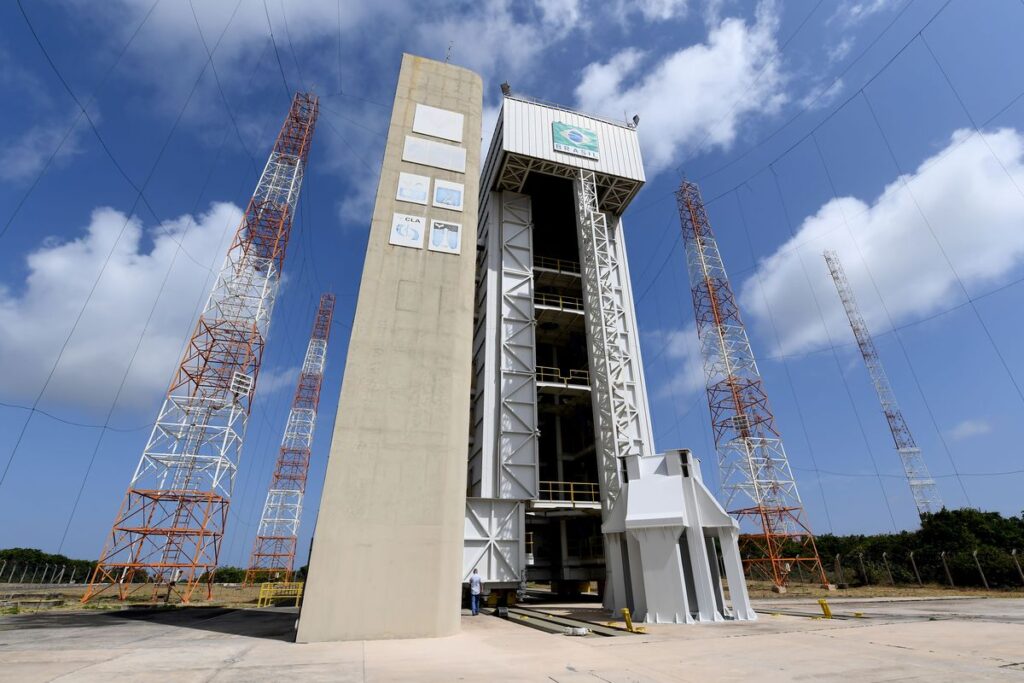
The Alcântara Space Launch Center, Alcântara, Maranhão © 2024 Getty Images
Collective Titling: An Unfulfilled Promise
According to a Terra de Direitos factsheet, titled “Quilombola Titling” (2024), if the Brazilian government continues at its current pace of granting titles to Quilombola territories, it will take 2,708 years to “title all the territories of the 1,857 quilombos with open processes at the National Institute for Colonization and Agrarian Reform” (or Instituto Nacional de Colonização e Reforma Agrária), also known as INCRA, the federal body responsible for Quilombola land regularization. By 2024, only 57 territories had been either partially or totally titled by INCRA since the property rights of traditional Quilombola people was formally recognized by the 1988 Federal Constitution. Of the 54 territories that have been granted title, 33 received a partial title, meaning that the title only applies to one area of the territory to which the filing Quilombola community actually has full right to. In short, “only 24 have titles for 100% of the area”. The factsheet explains that, “The estimate does not include quilombola land regularization processes managed by states and municipalities, nor does it account for communities that have not been certified by the Palmares Foundation (FCP) [a federally-financed body that promotes Afro-Brazilian culture, including certifying quilombola territories] and, therefore, have not begun the administrative process with Incra”.
Many obstacles have been getting in the way of Quilombola communities obtaining rightful access to their collective land titles. For instance, the numerous stages to the land titling, notably certifying the territory, identifying and delineating it, recognizing it, declaring its social interest and finally, titling it, make it a long-drawn, unpredictable, and bureaucratic endeavor. Furthermore, the generations of institutional racism rooted in Brazil’s colonial and slaveholding history, make land ownership structures between non-white and white inhabitants of Brazil inherently unequal.
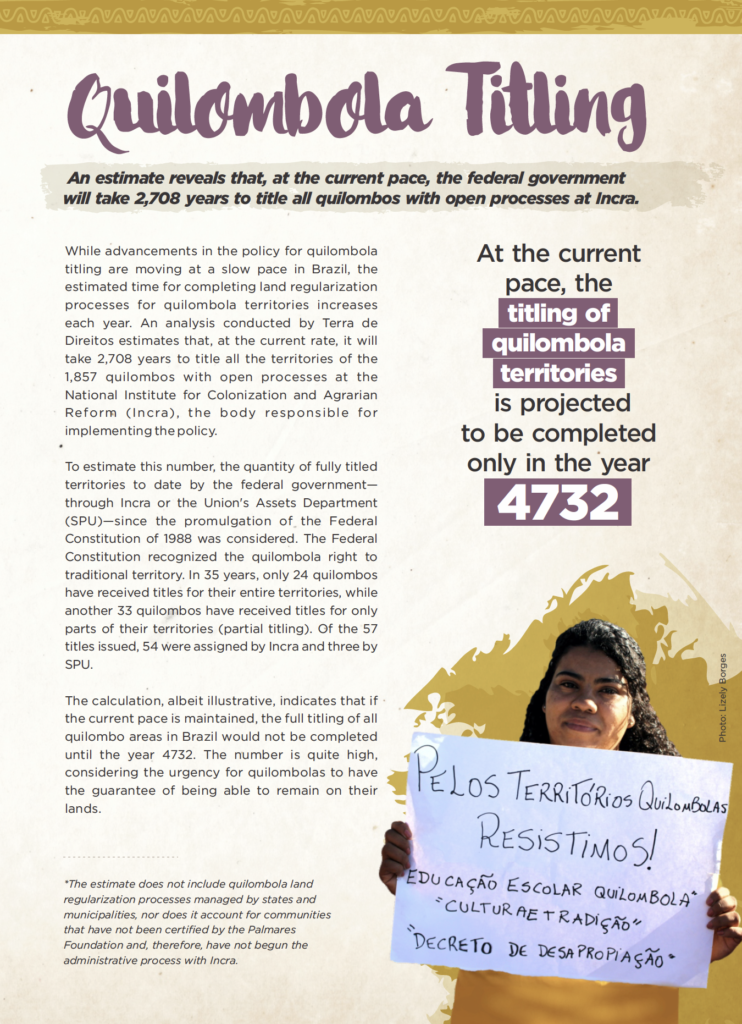
© 2024 Terra de Direitos
Recent Developments
In a historic decision on September of 2024, the Brazilian government and Quilombola entities have reached an agreement pertaining to the use of the Alcântara Space Base (CLA) and the protection of the rights of local communities, that is 152 remaining Quilombola communities in Alcântara, Maranhão, who have been directly impacted by the establishment CLA in the 1980s.
The pact was announced on September 19th in Maranhão, alongside President Luiz Inácio Lula da Silva. Its goal is to put an end to the 40 years of ongoing disputes between the Brazilian state (the Brazilian Air Force and the Ministry of Defense), who claimed the need to preserve land in Alcântara for the potential expansion of Brazil’s aerospace program and Quilombola communities of Alcântara, who have claimed historic ties to the land on which they depend for their subsistence and community health [source].
You can learn more about the intricacies of this agreement in the Timeline StoryMap below.
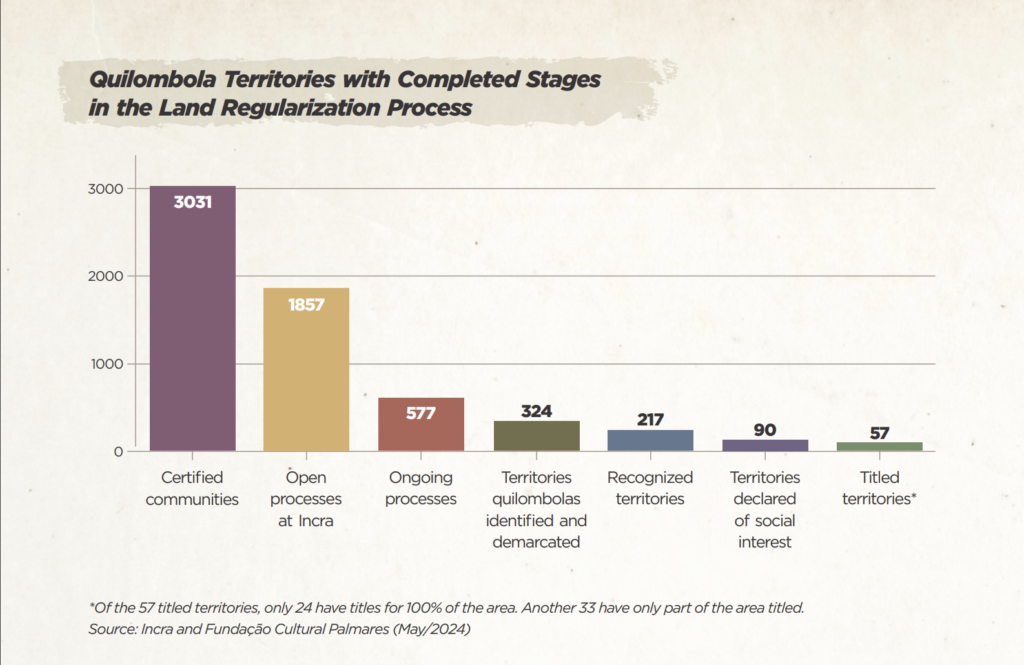
© 2024 Terra de Direitos
“When the state found us, we lived from the collective title. We lived in harmony. . . For that, society, youth, need to participate. Because the future will only be uncertain when you don’t know what to do. . . . We, the Alcântarans, are a resilient people, we know how to wait.”
– Inaldo Faustino Silva Diniz, São Raimundo (displaced to Agrovilla Marundá) – Community Leader & Elder
Forty Years of Resistance to Land Dispossession: A Deep-Rooted Colonial Legacy
The region of Alcântara located in the Northeastern state of Maranhão, Brazil, which was formerly inhabited by the Tupinambás Peoples, has a history of European settler colonialism dating back to the 17th century. From a booming slave-run economy in the 18th century, to a declining plantation market in the 19th century, Alcântara experienced Portuguese White flight in the late 19th century. This phenomenon led to the formation of multiple autonomous social groups, today known as Quilombos, who had been left behind by plantation lords.
Known for our land-based collectivist cultures and ways of life, we, the Quilombos of Alcântara, lived removed from the intervention or support of the government until the 1970s when the Brazilian military started to lay claim to parts of the territory, thus displacing many of our Quilombola communities from their homes. In 1980, the Space Launch Center of Alcântara (CLA) was approved for construction in the region without prior consultation or consent from our local communities, leading in 1986 to its construction and to the forcible displacement of 32 of our Quilombola communities (more than 300 families), under the guise of a national security rhetoric. The CLA location was chosen due to the predictable weather, open ocean, and its 169 mile-distance from the equator – where the Earth rotates at a higher speed [source].These 502 displaced people were resettled to areas near the CLA called “Agrovilas” to live in military-built homes where growing their food and fishing became near-impossible.
In response to these human rights violations, social movements began to form, all the while the 1988 Federal Constitution guaranteed the right of collective titles of Quilombo territories across the country. In 1989, the International Labor Organization Resolution 169 recognized the territorial rights of Indigenous and tribal peoples, while in 2003 President Lula enacted Decree 4.88 of 2003 to establish procedures leading to the granting of the collective title. It is, however, not until 2020 that ILO acknowledged that the right of Quilombola communities to Free, Prior, and Informed Consent had been violated through the approval and construction of the CLA.
In 2020, the Brazilian government announced in a decree its plan to expand the CLA by over 30,000 acres, which could lead to the displacement of over 2,100 peoples from communities in the regions, which have been founded hundreds of years ago by their escaped enslaved and freed ancestors [source]. A case at the Inter American Court of Human Rights concerning the human rights violations committed by the government on Quilombola Communities of Alcântara has been pending for a decision since 2023. The precedent-setting decision shall be taken in 2024.

Alcântara Quilombola leaders bring a historic case against Brazil to the Inter-American Court of Human Rights in Chile in 2023 © 2023 International Court of Justice Multimedia Galleries
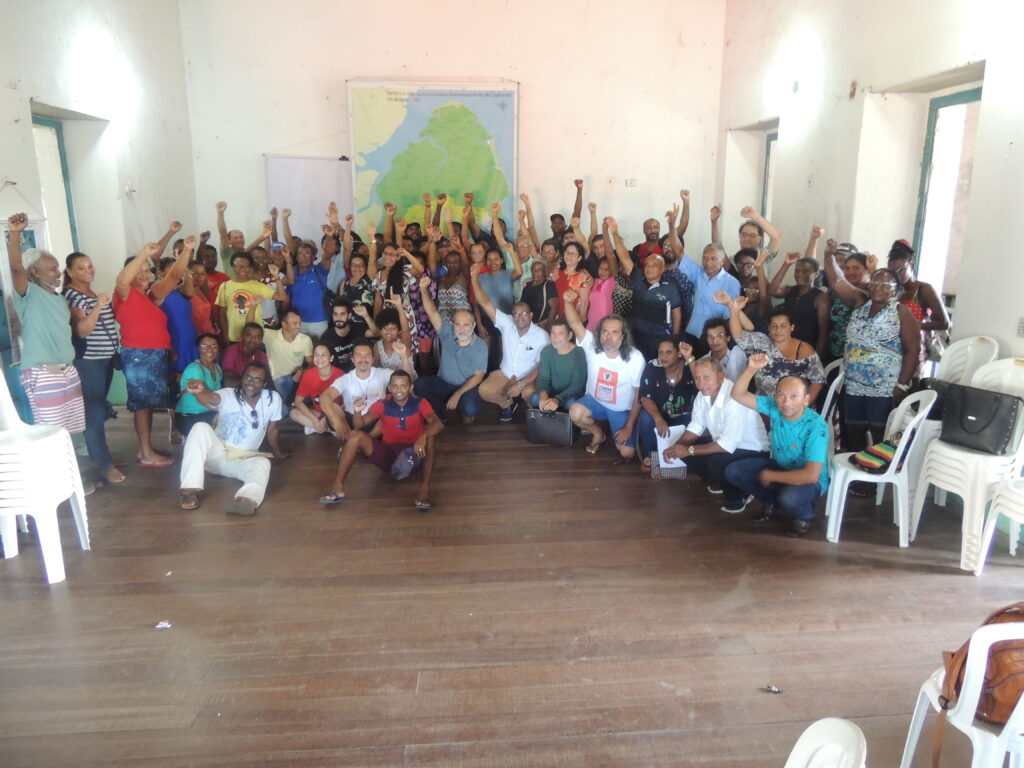
Quilombolas discussing ILO Convention 169 in Alcântara, Maranhão © 2024 Davi Pereira Júnior
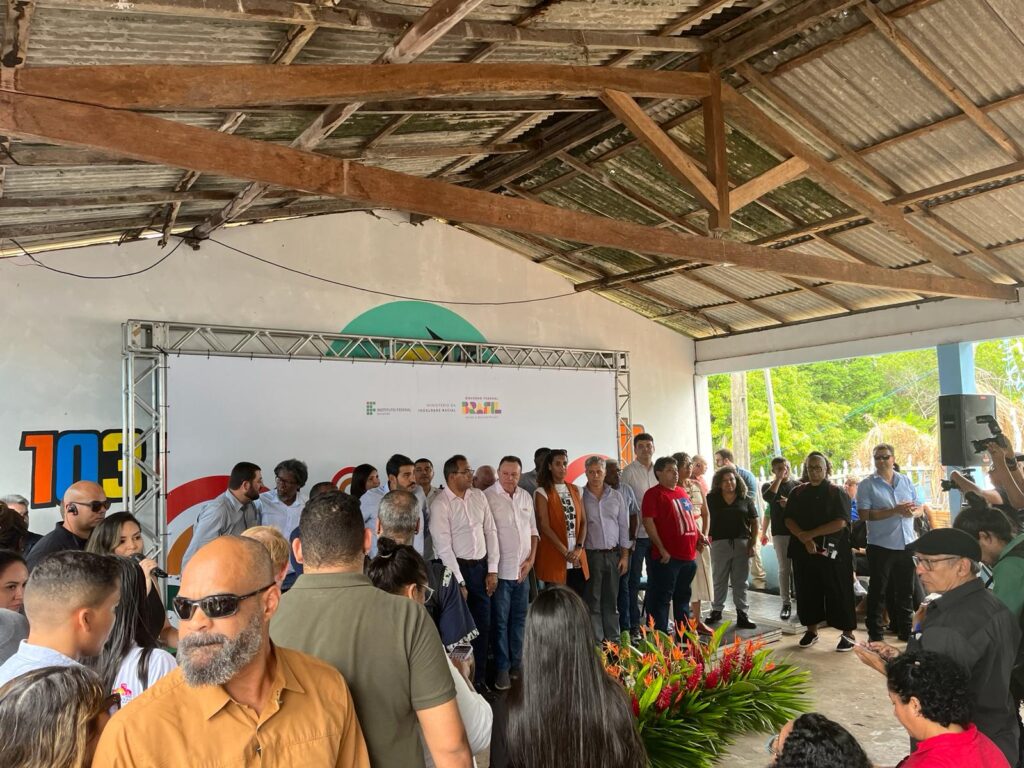
Brazilian Ministers paying the Quilombos of Alcântara a visit in Canelatiua Quilombo, Alcântara, Maranhão © 2024 Cat Diggs

The Alcântara Space Launch Center, Alcântara, Maranhão © 2021 Brazilian Space Agency
About the Alcântara Space Launch Center (CLA)
Although the Alcântara Space Launch Center, or CLA, was initiated in 1986, a space agency in Brazil had been established years before during the country’s military dictatorship, which formally ended in 1985. Land clearance for the CLA began in 1980, six years before the construction of the facility, leading to a first wave of mass displacements among Quilombola communities of Alcântara. Alcântara’s proximity to the equator and to the ocean makes it an ideal and cost-effective location for space launches, both domestic and international, prompting the Brazilian government to develop numerous strategies for removing Quilombola communities from our lands, rather than honoring our constitutional rights to traditionally occupy our territories.
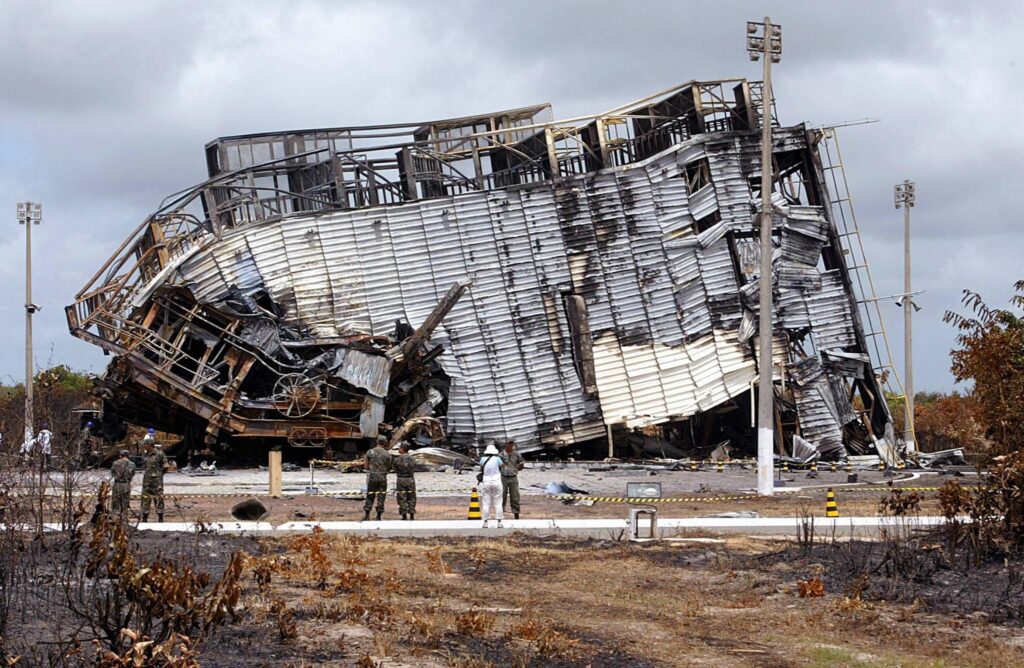
Wreckage at the Alcântara Launch Center following the 2003 VLS-1 V03 explosion, Alcântara, Maranhão © 2024 Agência Brasil
Archival footage of Alcântara Launch Center launches, Alcântara, Maranhão © 2024 Brazilian Air Force
The Unmonitored Environmental Damage Wrought by the Space Launch Center
The Alcântara Space Launch Center (CLA) is situated near the coast, and its construction has displaced numerous Quilombola communities along the coastline. According to Danilo Serjo, a Quilombola lawyer and author, the government’s failure to conduct an environmental impact assessment of the CLA has led them to completely overlook the negative impacts that the construction of the CLA has caused to the livelihoods of our Quilombola communities whose forcible displacement to unfamiliar regions of Alcântara has threatened their food security, their ability to subsist off the land, and their sense of cultural identity.
The economic benefits promised by the CLA have not justified the social and environmental ecosystem destruction caused by its construction. In fact, 56 percent of the residents of Alcântara still live below the poverty line despite over 30 years since the center’s construction. President Bolsonaro’s rejection of G7 aid to protect Brazil’s sovereignty during the Amazonian fires in 2022 stands in stark contrast to his eagerness to hand over control of the CLA to the U.S. Some critics highlight provisions in the 2019 agreement between Trump and Bolsonaro that would grant the U.S. power to restrict access to the base and allow for the storage of radioactive materials and other harmful substances at the CLA without the consent of the Brazilian government [source].
The incident at the Alcântara Space Launch Center in 2003, where a rocket explosion claimed the lives of at least 21 people, underscores the human and environmental risks associated with Brazil’s space ambitions [source]. The government’s neglect of Quilombola displacement issues and its inadequate environmental oversight over the CLA has led to systemic problems, including the failure to acknowledge our Quilombola land rights and to address environmental degradation caused by the CLA, such as the contamination of ocean waters and marine life that we, Quilombola communities, have depended on for generations for our subsistence and livelihoods.
Key Players in the Struggle
Although the struggle for collective land title encompasses several groups and entities, the following four organizations have been leading the charge in the Quilombola social movements of Alcântara to assert their right to collectively occupy their lands. To learn more about these organizations, visit the About Us page.
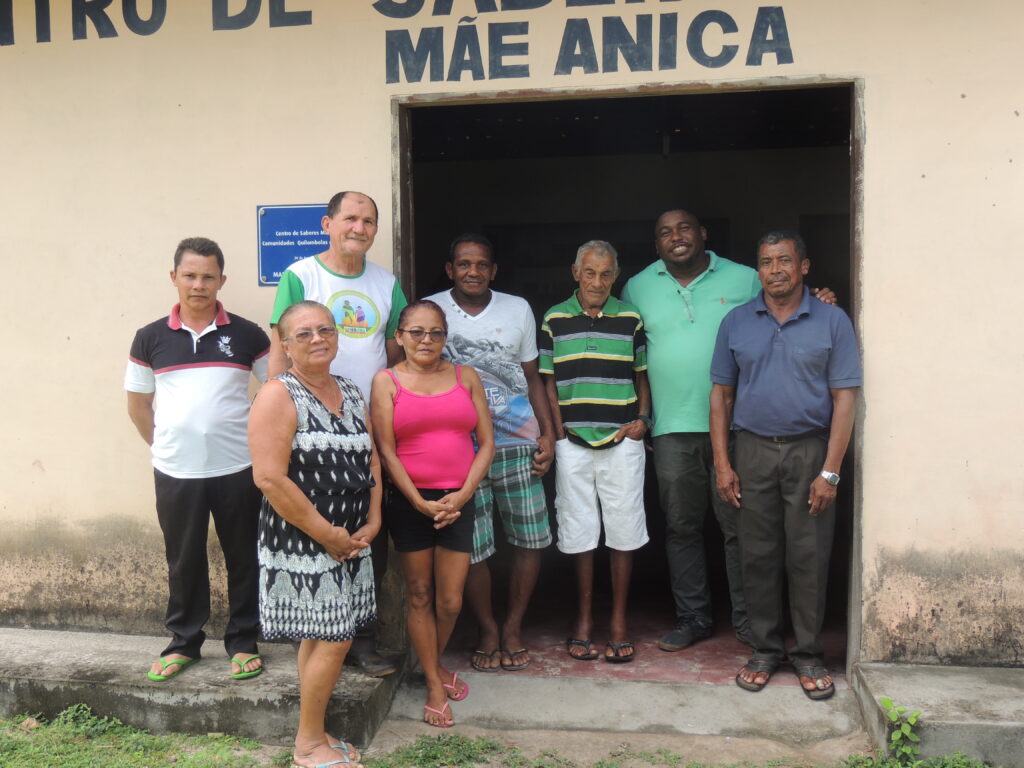
Community meeting in Canelatiua’s Knowledge Center, Alcântara, Maranhão © 2024 Davi Pereira Júnior
ATEQUILA
The Association of the Alcântara Ethnic Territory was founded in 2018 to receive their communities’ rightful collective land title from the Brazilian government. ATEQUILA represents close to 156 communities, of which 71% occupy the Alcântara region.

Director of MABE giving a presentation during a plenary meeting in the City of Alcântara, Maranhão © 2024 Davi Pereira Júnior
STTR
Alcântara Union of Rural Workers (STTR) was founded in 1971 to defend Quilombola communities against displacement and human rights violations and ignited a social movement in the region.
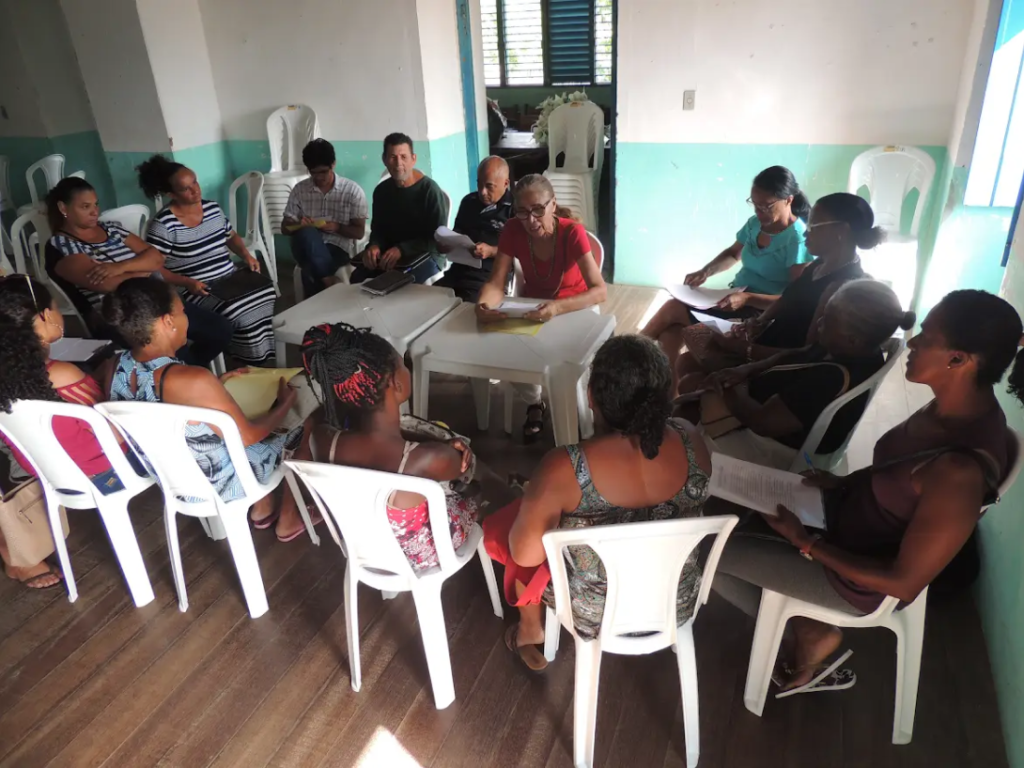
Group work during a plenary meeting in the City of Alcântara, Maranhão © 2024 Davi Pereira Júnior
MABE
The People Affected by the Alcântara Space Base Movement (MABE) was founded in 1999 by Quilombola community leader, Dorinete Serejo Morais. It works to organize the Quilombola communities directly impacted by the Alcântara Space Launch Center.
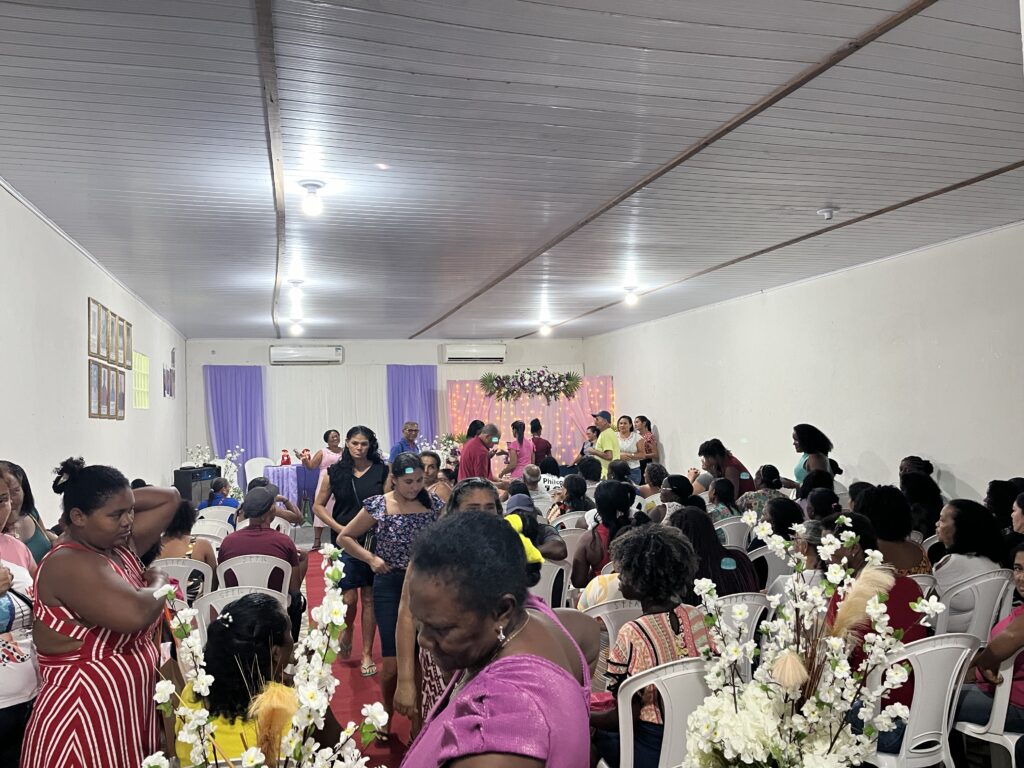
MOMTRA meeting in the City of Alcântara, Maranhão © 2024 Cat Diggs
MOMTRA
Alcântara Rural Women Workers Movement (MOMTRA) was founded formally in 1992 and centers gender equality and women’s health in the struggle for territorial rights and identity in rural, and most recently, urban communities in Alcântara.
Quilombos of Alcântara Timeline
Below is a detailed timeline of the complex and intersecting events that have shaped the current sociopolitical landscapes of the Quilombos of Alcântara.
YOU CAN FIND THE ENGLISH VERSION OF THIS TIMELINE STORYMAP AT THIS LINK.
